West Bengal tourism has so much to offer. Given that Delhi to Kolkata flights are mere 2 hours or so, it is almost a weekend destination. This time, we take you to a famous temple in Kolkata. The Dakshineswar Kali Bari is a remarkable specimen of Bengal school of architecture. Dedicated to Goddess Bhabatarini, an aspect of Kali, this temple is a hidden gem of West Bengal for Delhi folks.
Contents
Trip to Dakshineswar

The communist rule in West Bengal has left a deep-rooted impact. From experience we can say, Bengalis have a flexible relationship with Gods. They fear Gods less but fuss about them more. Hence, temple tourism takes precedence than pilgrimages in West Bengal.
When you search for things to do in Kolkata, there are a couple of temples in Kolkata or surrounding areas that show up. The Dakshineswar Kali Bari or Kali Temple is one such place. We could see visiting this temple is a popular activity in this part of India since, even when we asked a resident about things to do in West Bengal; they would invariably mention this temple. We therefore visited this shrine during our first time, Kolkata.
The temple is situated at Dakshineswar, a town in the district North 24 Parganas at the fringes of Kolkata. Built on the bank of the River Ganga, Dakshineswar Mandir creates a beautiful silhouette. Unlike many other temples of India, Dakshineswar temple dress code is pretty relaxed. No, you don’t have to wear a dhoti, or kurta-pyjama, or sari. It is a house of God, so any clothing that is not disrespectful is acceptable.
Irrespective of caste, creed, religion or gender, Dakshineswar Temple is open to all.
Who built Dakshineswar Kali Temple?
The worship of feminine power has been in prevalence in the Indian subcontinent since the beginning of civilization. As we all know, seals bearing impressions of the Mother Goddess was excavated during Harappan sites. The worship of the Divine Mother continues till the present day as Durga, Lakshmi, Kali and so on. Goddess Kali is one such form who on the one hand is the slayer of evil and on the other hand, is the benefactor. Kali worship is perhaps more popular in Eastern India where innumerable shrines have been dedicated to Her.
At this point, some basics about Dakshineswar would not be out of place. Dakshineswar Temple was built by Rani Rashmoni, a philanthropist and widow of a wealthy zamindar of Bengal. Rani Rashmoni became a devotee of Goddess Kali in her later years. She dedicated the Dakshineswar Temple to Bhabatarini, a benevolent aspect of Goddess Kali. It took about 9 years to raise this shrine and worship started in the year 1855.
The star of the Dakshineswar Temple has been Sri Ramakrishna Paramahansa Dev. This mystic saint of Bengal functioned as the priest of the Bhabatarini shrine of Dakshineshwar in the early years of the temple’s establishment. Sri Ramakrishna has devotees all across India and abroad. They have also contributed in making Dakshineswar Temple a popular place to visit in West Bengal.
How to reach Dakshineswar Temple
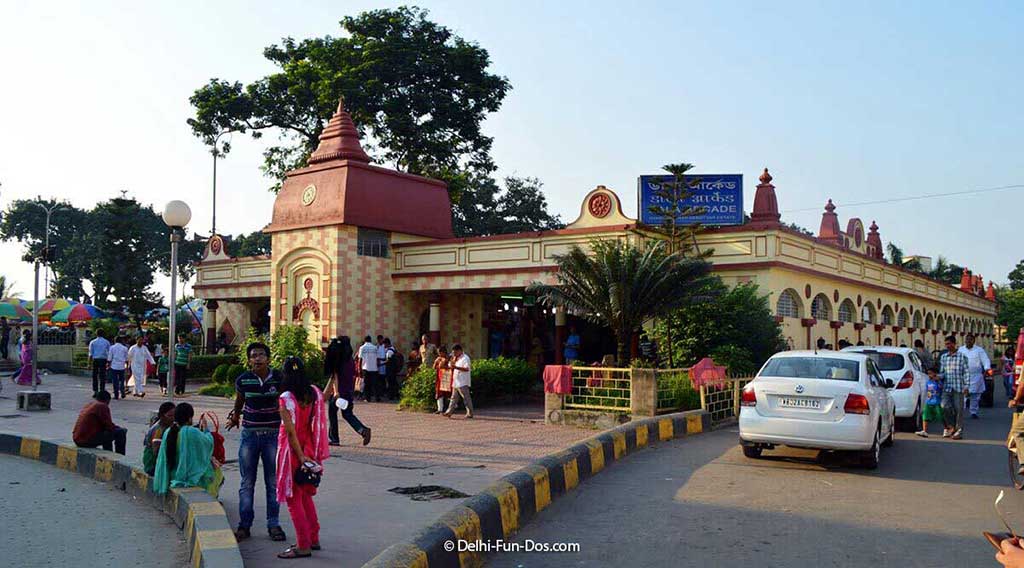
Kolkata to Dakshineswar Temple is about 12 to 15 km. We had taken the famous yellow taxi of Kolkata on our way up and reached Dakshineswar Temple in about 45 minutes. Dakshineswar is also well-connected with the city through public buses, radio taxis and local trains. The nearest railway station to Dakshineswar Kali Temple is Dakshineswar Railway Station.
Dakshineswar Kali Temple via metro is also an option. If you are taking the metro, we suggest you drop at Shyambazar Metro Station and exit from gate no. 4. You can take a taxi or a shared auto-rickshaw for a 15-20 minutes ride from here.
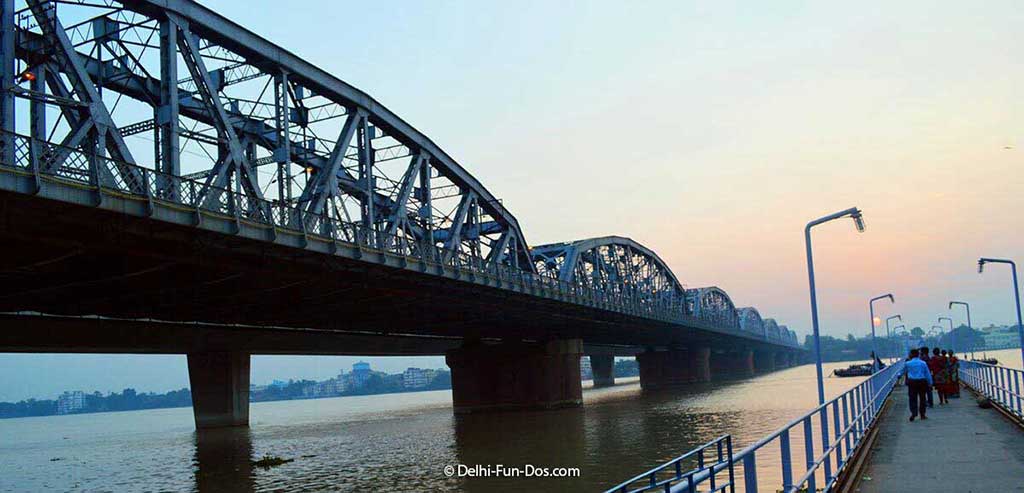
On the way back, for variety, we tried the Dakshineswar ferry service. We took a ferry ride across Ganga from Dakshineswar Ferry Ghat and crossed over to Belur Math. Belur Math to Kolkata was a fun ride on a quaint local train.
Dakshineswar Temple guide
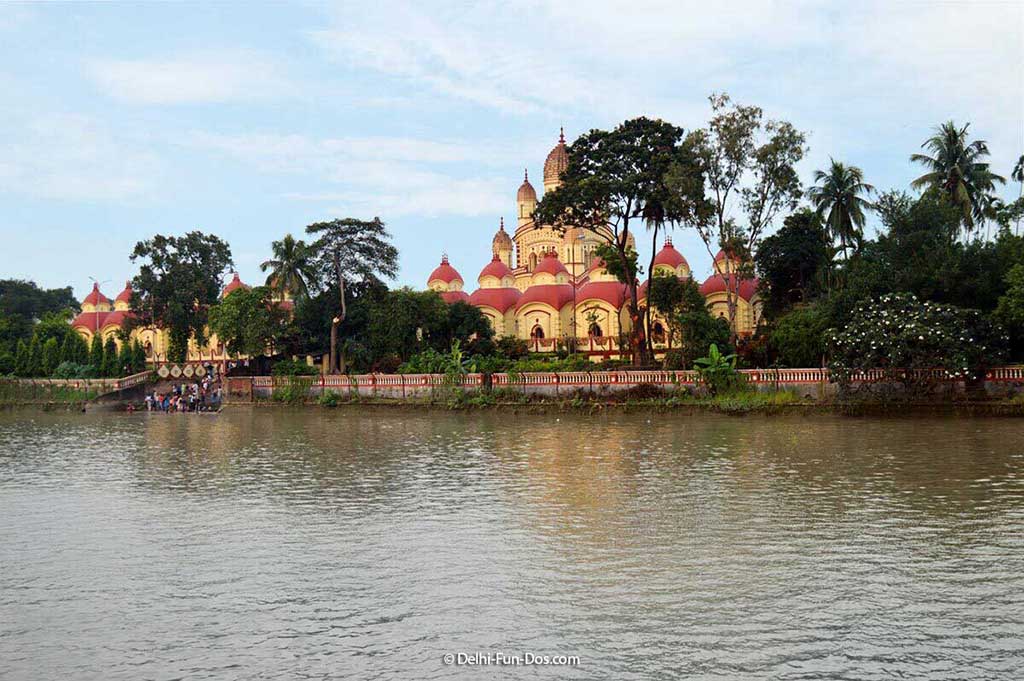
The Dakshineswar Temple is built in the Navaratna style of Indian Temples, also inherent to Bengal school of architecture. Ergo, it has nine spires divided between 3 roofs. Given the height, we could see the yellow ochre structure, with dark red border, from a distance. Against the blue autumn sky, the temple was a spectacular sight.
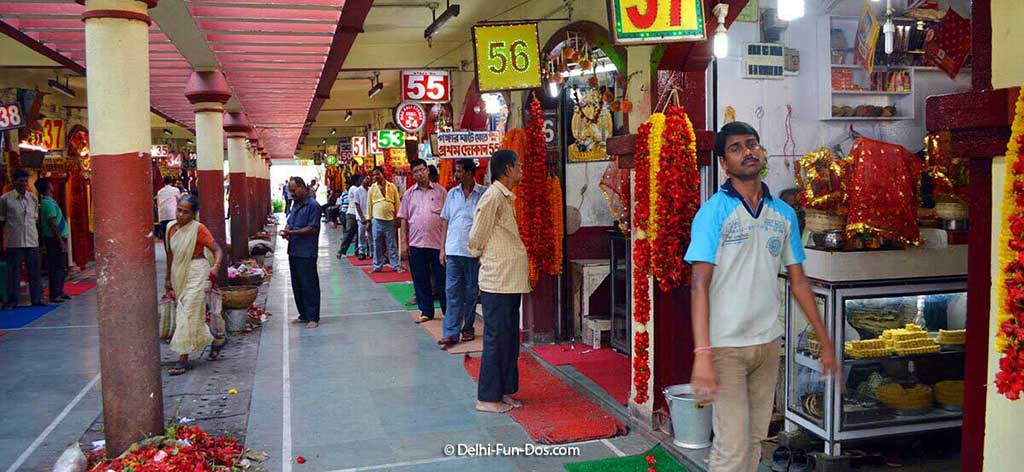
The Dakshineswar temple complex has an ear-marked zone for selling flowers, fruits, sweets and other worship items on the outer boundary wall. Some of these shops have been doing business for over a century.
When we entered the complex, we landed at a cast open courtyard. The main shrine housing the Bhabatarini idol is at the centre of this courtyard. There is another smaller shrine that has a Radha-Krishna Temple. 6 separate Shiva temples are lined on both sides of the courtyard overlooking the Ganga. These small shrines, 12 in all, called Barah Mahadev, are built in the Aatchala or 8-roofs style of Bengal architecture. Each temple houses a Shiva Linga. The Shiva temples add a beautiful perimeter to the temple complex.
The main temple is placed on a high plinth and one has to climb a flight of stairs to reach the corridor that surrounds the Garvgriha or the sanctum sanctorum. As we discussed in our post about Kailasa Temple, like all other Hindu temples, the sanctum sanctorum is very small and not many people can enter simultaneously.
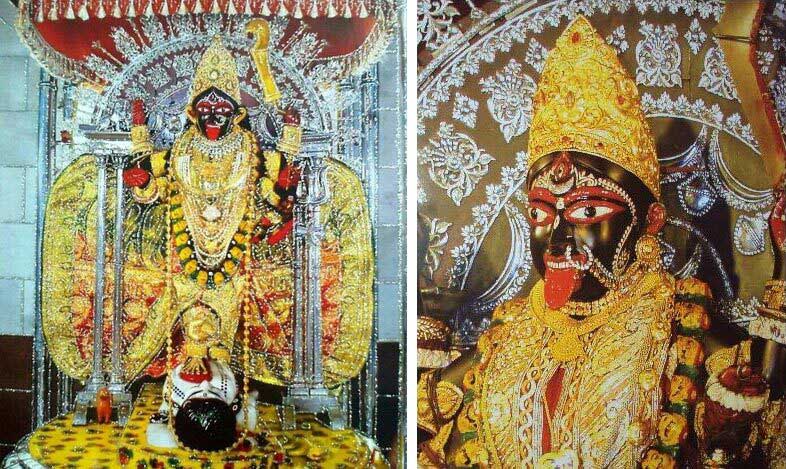
Source: Pinterest and Wikipedia
The Bhabatarini idol is placed inside an elaborate silver altar. She stands on a pedestal of silver lotus with thousands of petals. The Bhabatarini statue is made of black stone. She has four-arms and the right arms are in Barabhay or blessing mudra. The left arms represent the slayer of evil. Below her feet lies the statue of Lord Shiva, her consort. The Bhabatarini statue is draped in a Benarasi sari and is decked, in fact, covered, with gold ornaments and jewellery made with precious stones. She wears a gold crown on her head and has a silver halo behind her. Her face has long eyes painted in red with a third eye on the forehead and the tongue protrudes out from the lips. The imagery emanates compassion, aggression yet detachment at the same time. On special occasions, the deity is adorned with a flower crown and other floral ornaments. The grandeur reminds us of Goddess Kanak Durga in Vijaywada.
Devotees mostly visit the Bhabatarini shrine first and then move to the other shrines. There are long queues on Tuesdays and Saturdays, special days for worship to Kali; Naboborsho – the Bengali New Year; and weekends. Kali Puja is the chief festival celebrated here and the temple is very crowded that night. However, the courtyard surrounding the temple is extremely spacious. Hence, while visitors may have to wait in queues to visit the shrine and make offerings, there is never a stampede like situation.
Besides the main shrine, there is a separate single-storey building with columns. This houses a Radha – Krishna temple and a Lakshmi – Narayan temple. The idols here are beautiful examples of Bengal style votive sculpture. We can see much of this style in the shrines of Bishnupur or the temples of Vrindavan.
Worship at Dakshineswar Kali Temple
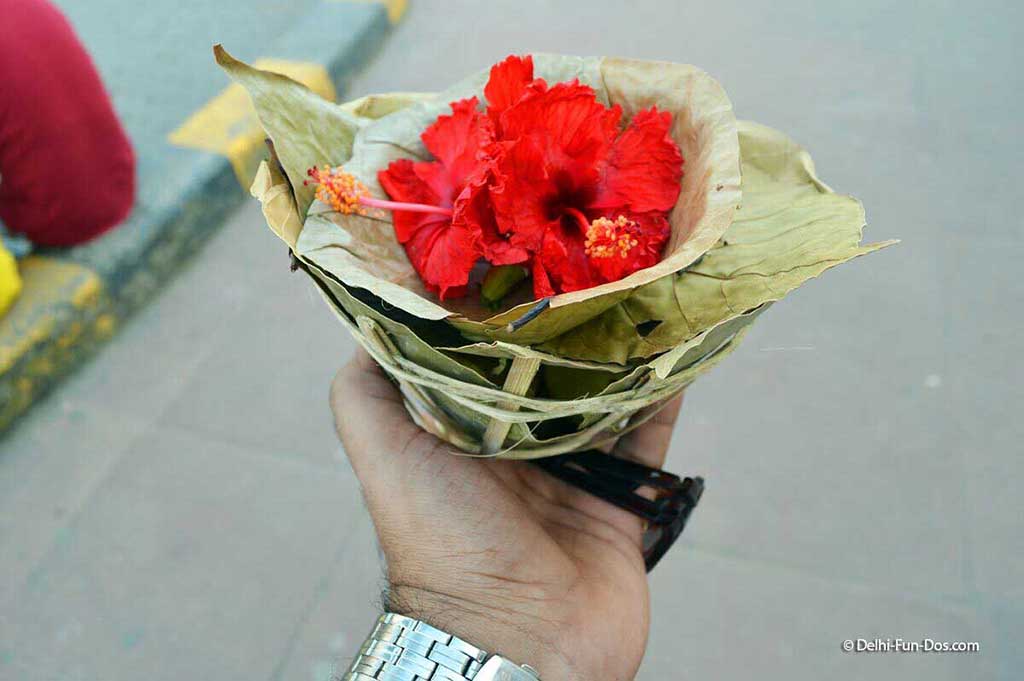
There is no fixed form of worship at the Dakshineswar Kali Temple. One does not even need to be a believer for visiting the shrine. That said, only if a devotee wants, they can buy assorted offerings that compromise flowers, sweets – Peda and incense sticks. The priest in the Bhavatarini shrine consecrates the offering and returns to the devotee. If one wants to make donations or gift a valuable item, they have to approach the temple office in the compound. Unlike many Shakti temples, animal sacrifices are not allowed in Dakshineswar Temple.
A visitor can partake Bhog or food offerings to the deity that is distributed during lunchtime in the community dining hall. One has to purchase a coupon at a very reasonable price for that.
Simple marriages are also held in the temple.
Dakshineswar Kali Temple timings
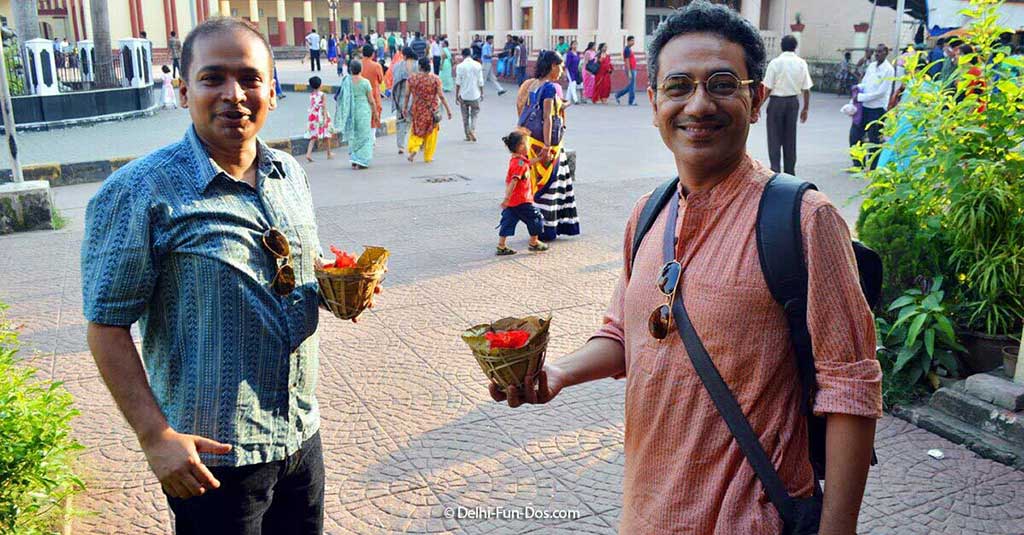
The temple timings change during summer and winter months. Between October and March, the temple is open from 6:00 a.m to 12.30 p.m in the day and from 3:00 p.m to 8:30 pm in the evening.
Between April and September, the temple is open from 6 a.m to 12.30 p.min the day and 3:30 p.m to 9:00 pm in the evening.
During special occasions, like Durga Puja and Kali Puja, the timings vary and the temple is open longer.
Sri Ramakrishna at Dakshineswar Kali Temple
Sri Ramakrishna Paramhansa Dev was a mystic saint who emerged as a religious luminary of 19th century of Bengal. He was appointed as a priest at the Dakshineshwar Kali Temple at a very early age and virtually spent all his life here with Sarada Devi, his wife.
Sri Ramakrishna was a worshipper of female divinity. However, he was very libertarian in his views. He advocated that all religions were equal and were just different paths that led to God. He trained himself in various religious philosophies and meditated in the Panchabati Garden of the Dakshineswar temple. Sri Ramakrishna lived between 1836 and 1886 and innumerable visitors came to Dakshineswar temple to meet this saint.
Sri Ramakrishna’s presence gave the Dakshineswar temple enormous fame. His most celebrated disciple Swami Vivekananda created Ram Krishna Mission to preserve and advance his guru’s legacy.
The simple room where Sri Ramakrishna stayed in the Dakshineswar Temple premise has been maintained as it is. One can visit the room in silence and devotees can sit and meditate here.
Other interesting places near Dakshineswar Kali Temple
A trip to Dakshineswar Kali Temple can take about 2 hours to half a day. There are other places of interest not far from this spot that may be covered during the trip.
Belur Math
Belur Math is the headquarters of Ram Krishna Mission. It is situated on the bank of River Ganga, virtually opposite to Dakshineswar Temple. We took a ferry across the river but you can also drive. The ride on Ganga was picturesque and fun. Belur Math has a beautiful shrine dedicated to Sri Ramakrishna. There are many other shrines as well as a publication shop here. Ram Krishna Mission has many publications in the field of religion, spirituality and philosophy. A trip to Belur Math evokes peace.
Adyapith Temple
Adyapith is another very popular shrine about 5 minutes drive from Dakshineswar Kali Temple. It takes about 15 minutes if you board a rickshaw. The temple complex has schools, orphanages and charitable clinics. The main shrine is made in white marble and houses three sets of idols in a vertical column. On the top are Radha and Krishna, below that, Adya, a form of Goddess Kali and at the bottom, a statue of Sri Ramkrishna. Adyapith displays a syncretic approach to conflicting worship styles of Hinduism. We love the cleanliness in this shrine.

There are many other temples in Kolkata. We came to know, Kolkata is eponymous to Kalighat. The Kalighat temple, housing a very abstract form of Goddess Kali, gives Kolkata its identity. After returning from Kolkata, family and friends would ask us, “Did you visit Kalighat temple?” We went to Kalighat on a subsequent visit.
Dakshineswar temple is relatively lesser known in North India. Yet, visiting Dakshineswar temple was a memorable experience. For one, the temple is a unique instance of Bengal architecture that has got diluted over time. It stands tall beside the River Ganga and the skyline is a photographer’s delight. The cleanliness inside the temple is remarkable and when we went, there was no jostling. The darshan or visitation happened very peacefully. The deity in combinations of black, white and red with the brightness of her attire evokes divinity to the devotee. But she could be an artist’s delight as well. The form is indeed unfamiliar in North Indian style of worship. Plus we did a ferry ride on the Ganga and also visited Belur Math in the same trip. All in all, it was a day done well and we still cherish the experience.
Pro-tip
- Mobiles phones have been prohibited inside the temple some years now so it is best to keep this outside.
- Photography or videography is not allowed inside the Dakshineswar Temple premises.
PIN IT
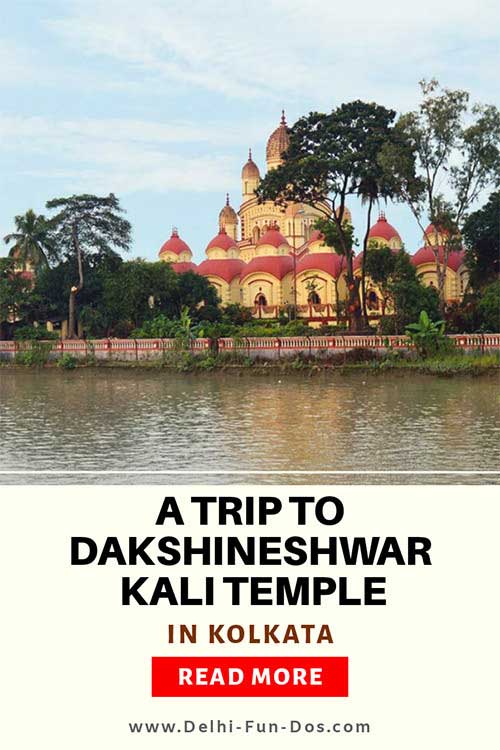

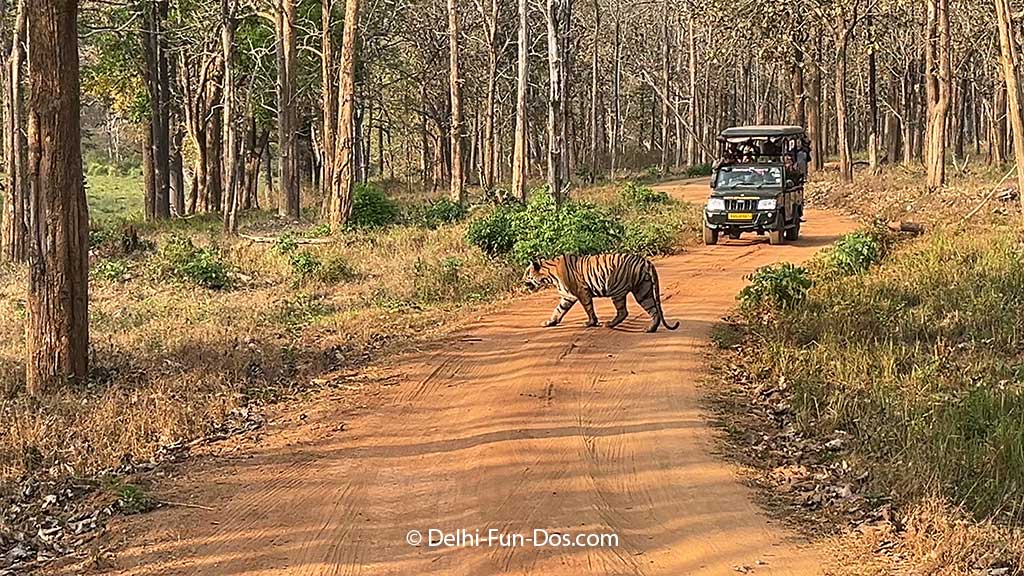
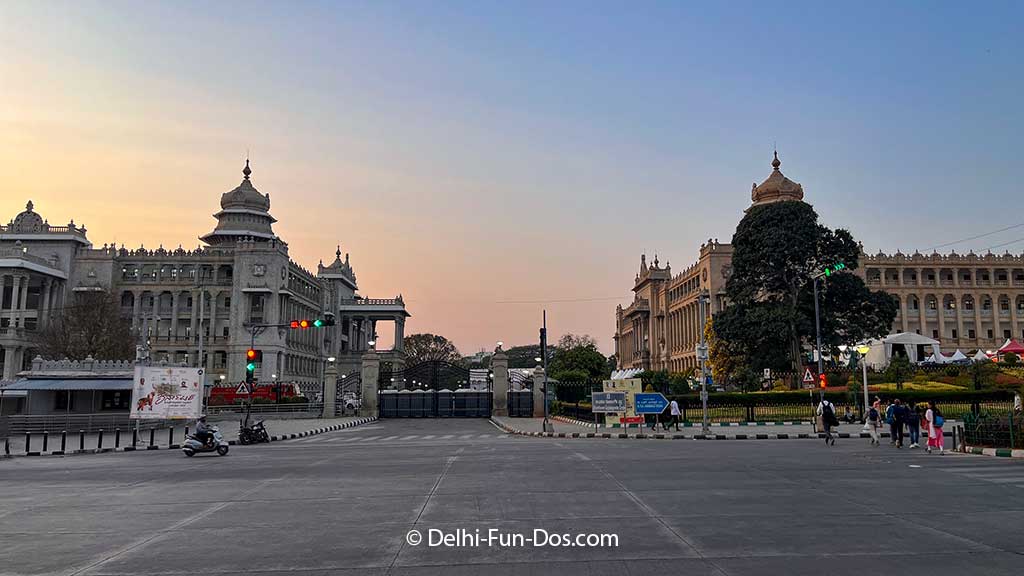
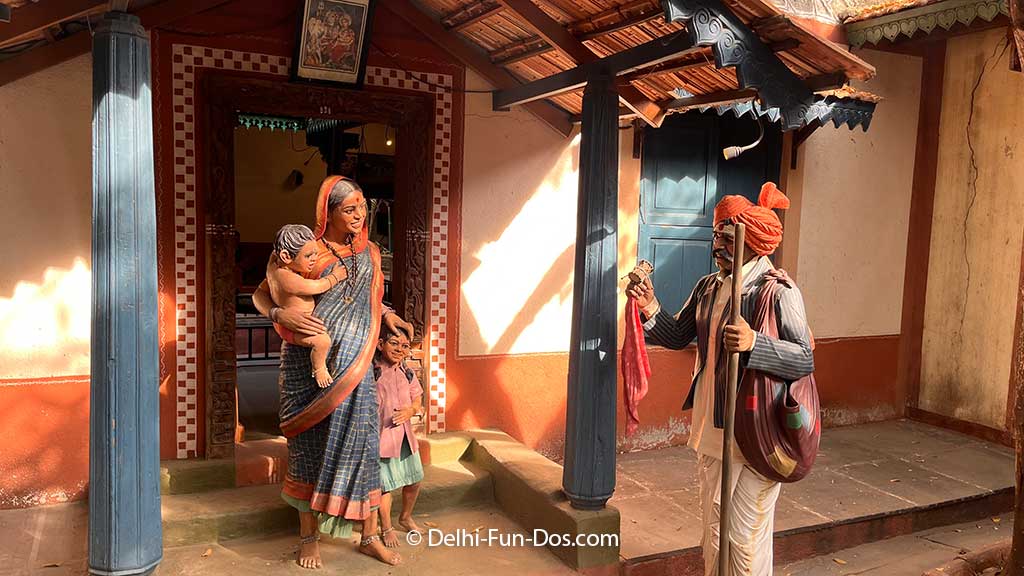
Oh this looks like a wonderful trip! I would love to go here someday too. Thanks for sharing.
I am located outside Kolkata, Is there provision to stay inside temple. Appreciate if you can provide some suggestions to stay since you travelled from Delhi.